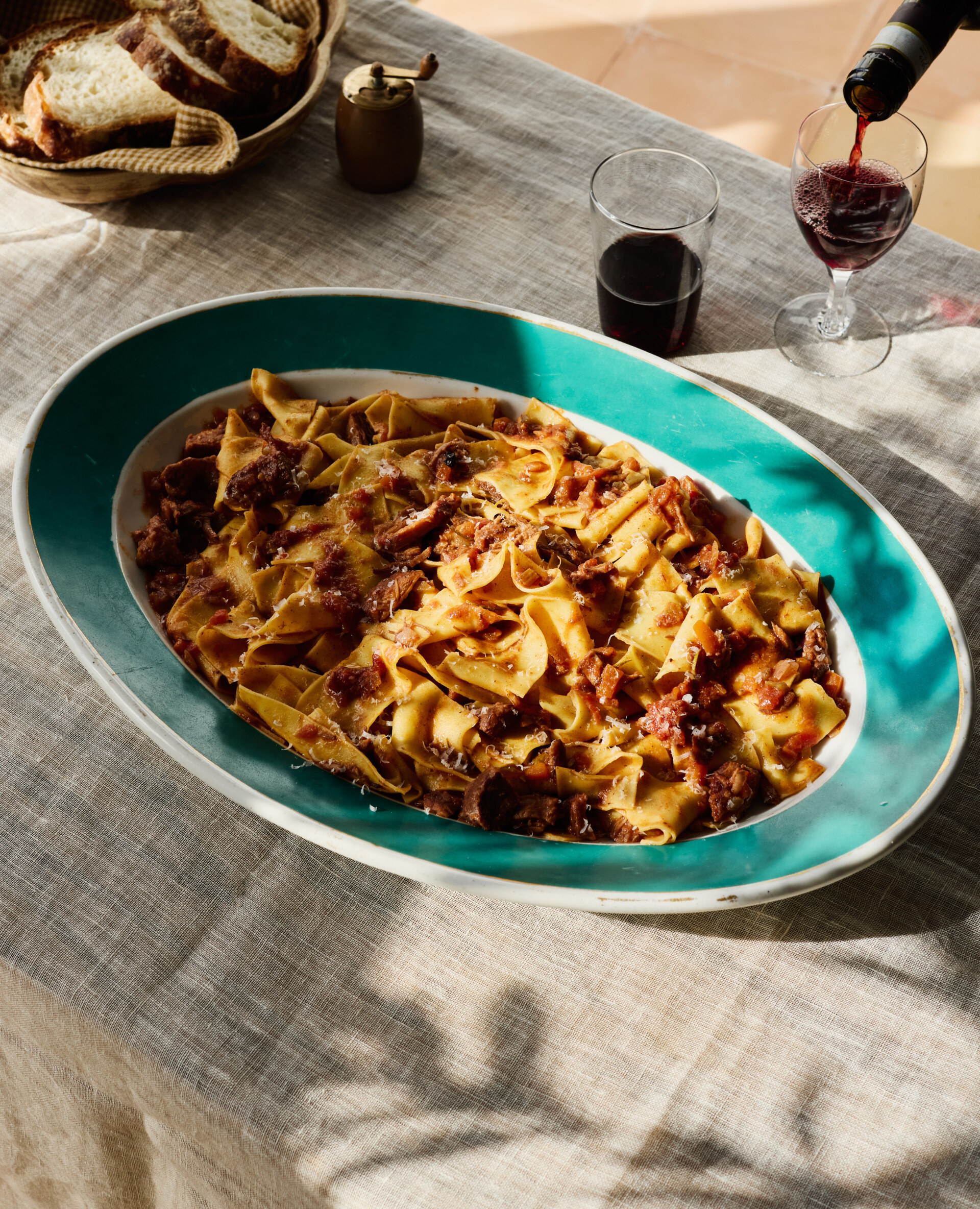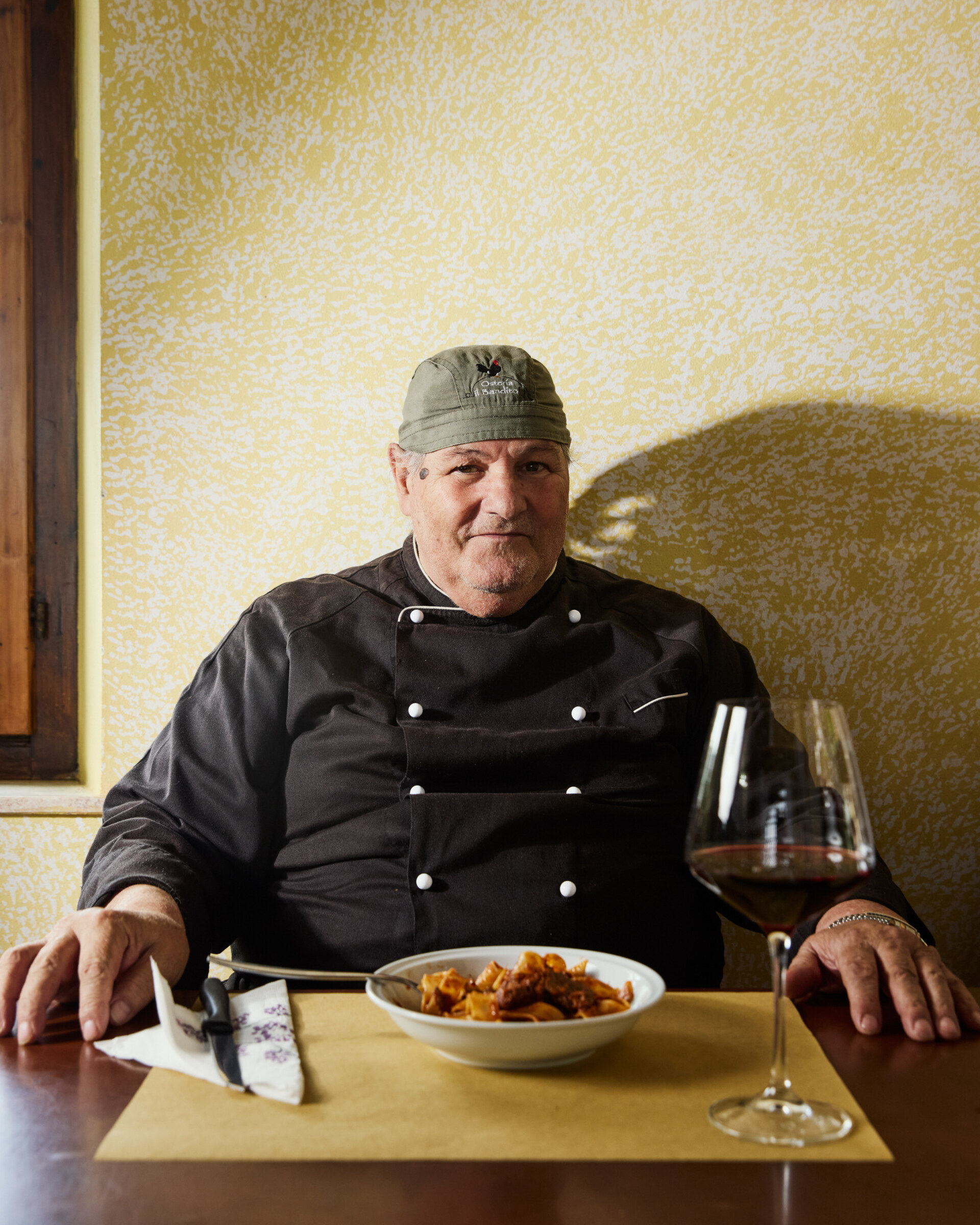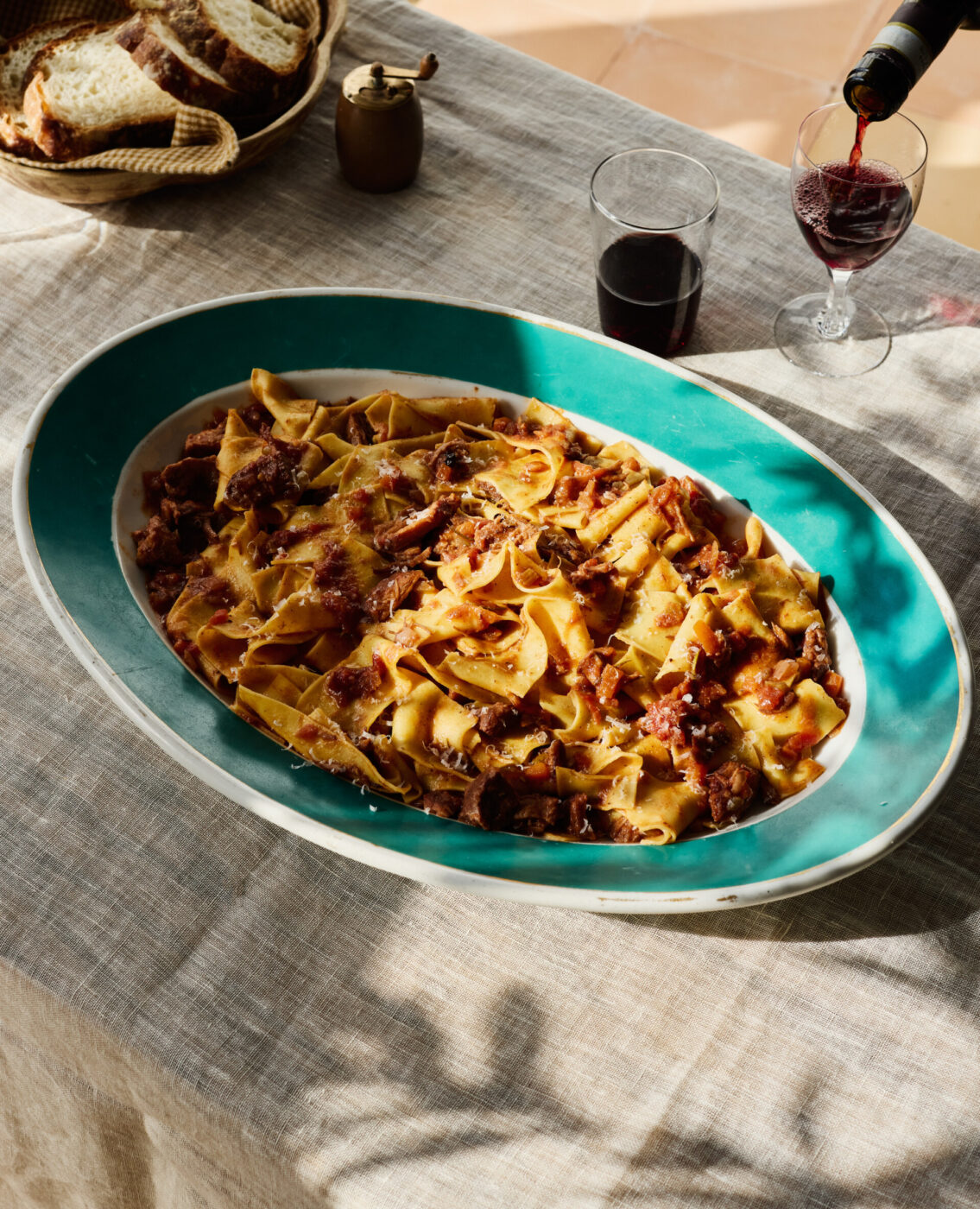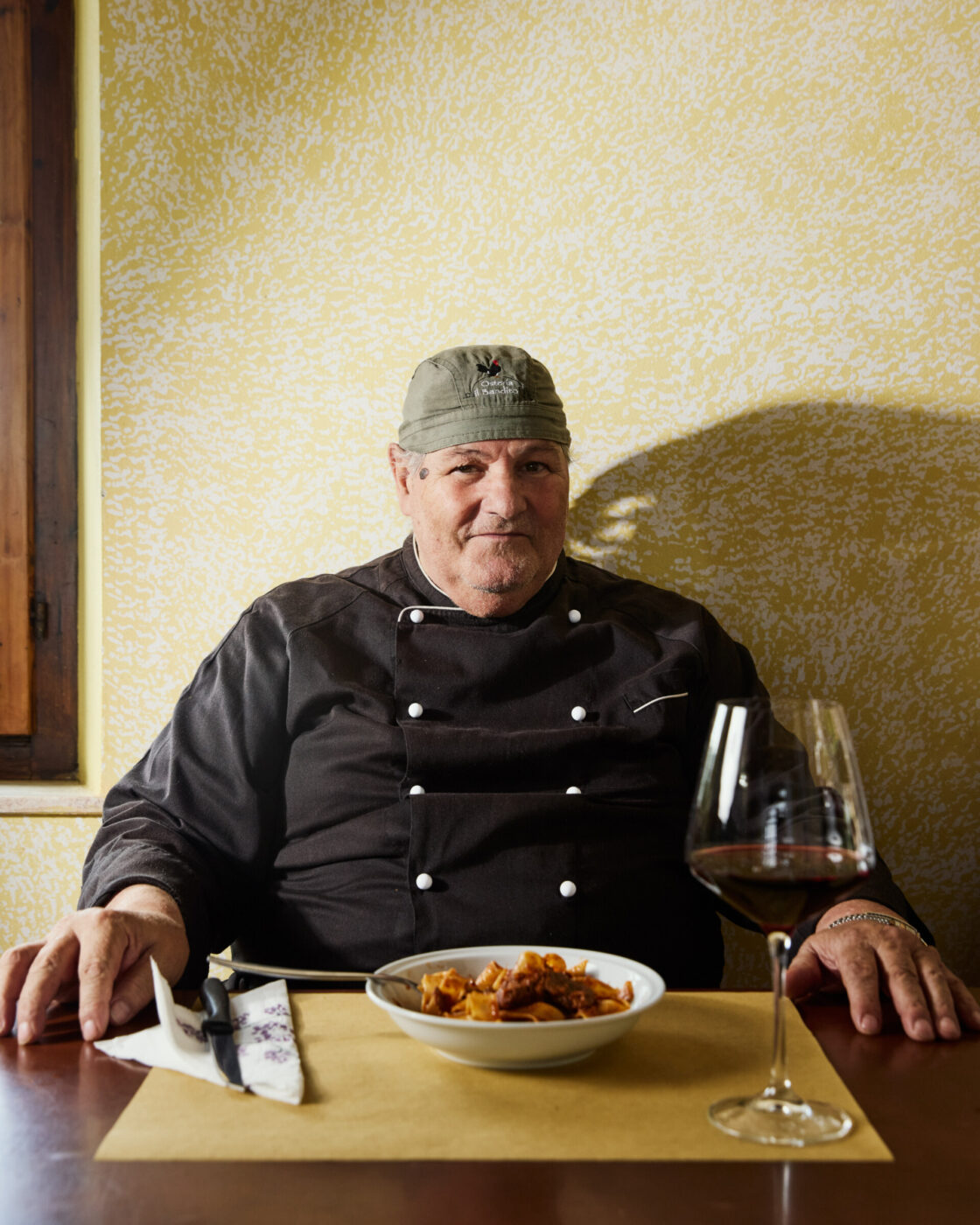Editor’s Note: The following comes from the pages of 20 Amici – 40 Ricette: Friends and Food from the Heart of Chianti, written by John Bersani, an Italian-American who’s been living in Gaiole-in-Chianti for the last 20+ years, and photographed by Nico Schinco (who’s also an Italy Segreta contributor!). “We came for the food, the wine, the culture, and the natural beauty. We’ve stayed because of the people,” writes Bersani of his small hilltop town. 20 Amici – 40 Ricette is dedicated as much to the former as it is to the latter, with the eponymous 40 recipes contributed by 20 Chianti locals, from top chefs to home cooks. The result is a mouth-watering cookbook that also reads as a rolodex of the heart-filled personaggi (characters) that call Chianti home. It will be published in 2025 by The Collective Book Studio.
Situated about ten minutes outside of Gaiole, high on a ridge near the small hamlet of Castagnoli, Osteria Il Bandito is everything you could want in a simple countryside trattoria. Don’t come expecting white tablecloth dining, cutting-edge cuisine, or a wine cellar filled with Super Tuscan treasures. Do come expecting breathtaking views of the surrounding area, the distinct smell of meat being grilled over live fire, a long list of classic pasta dishes, and the ever-present grin of the osteria’s chef/proprietor, Franco.
Franco–he’s the “Bandito”–is an interesting guy. Sardinian by birth, he’s yet another transplant to Tuscany who came to find work and has made Chianti his home for more than thirty years now. He started out in a nearby city as a bouncer at a discotheque, but eventually, maybe after the ouster of one too many unruly patrons, turned to what he really loves: food. This giant of a man loves to eat, that’s obvious when you meet him, and he loves to cook to make the people around him happy.
Assisted by his son and wife, this is strictly a family affair. It’s a no-frills operation that succeeds with personal attention to detail, an eye for quality ingredients, and an honest desire to present something simple but delicious every day.
Franco keeps things interesting with some dishes from the Sardinian tradition. If you call in advance, he’ll proudly prepare you his famous whole roasted suckling pig in the Sardinian style. His spaghetti dello chef brings together sun-dried tomatoes, dried fruit, nuts, hot pepper, and pecorino cheese in a burst of flavor from another place. It’s irresistible. Me? I gravitate toward the Tuscan classics. This Sardinian transplant has a way with all of them.

FRANCO’S PAPPARDELLE AL CINGHIALE (PAPPARDELLE WITH WILD BOAR SAUCE)
At some point during a Tuscan vacation, you will inevitably encounter some kind of pasta dish dressed with a wild boar sauce. It might seem off-putting, especially if you’ve ever met up with a wild boar or, worse yet, seen the film Hannibal. But I assure you, this is a dish you want to try.
Wild boar–cinghiale in Italian–are ubiquitous throughout the Tuscan countryside and a constant bane to local farmers and winemakers whose crops are routinely savaged by the beasts. It’s a constant war of wills. The annual wild boar hunting season, typically starting in early November and continuing until the ranks are adequately thinned out, is anxiously anticipated each year. And Tuscans being Tuscans, nothing goes to waste. Here’s Franco’s take on the classic.
Note: If you’re based in the U.S., it’s not impossible to find wild boar. D’Artagnan USA offers a quality product. You could substitute ground wild boar meat for the cubed meat specified in this recipe (and many Tuscans prepare the dish that way). But I like the texture of slowly braised and broken-down shoulder meat produced by the method below. Boar meat tends to be extra tough and gamey, hence a 24-hour marinade bath is your best bet to ensure a tender and pleasantly flavorful final result.
Serves 4 to 6
INGREDIENTS
- 1/2 bottle (375 ml) good-quality red wine (a Chianti would be ideal)
- 1/2 cup (120 ml) high-quality extra virgin olive oil, plus more as needed
- 1 bay leaf (may substitute dried if unavailable)
- 1 sprig rosemary
- 10 juniper berries
- 1 garlic clove, finely minced
- 2 pounds (910 g) wild boar meat (preferably from the shoulder), cubed
- 2 carrots, peeled and finely diced
- 2 celery stalks, finely diced
- 2 red onions, finely diced
- 1 tablespoon (15 g) tomato paste
- 1 (28-oz/784-g) can high-quality whole San Marzano tomatoes, hand crushed with their juices
- Kosher or coarse sea salt and freshly ground black pepper
- 1 pound (455 g) freshly made or dried pappardelle noodles
PREPARATION
- In a large nonreactive container (a plastic storage tub with a tight-sealing cover would be ideal), mix together the red wine, 1/4 cup (60 ml) of the olive oil, bay leaf, rosemary, juniper berries, and garlic. Toss in the cubed boar meat and mix everything together to thoroughly combine and coat the meat. Cover the container and place in the refrigerator overnight. Twenty-four hours of marination is ideal.
- After the meat has been marinated, it’s time to assemble and slowly cook the sauce. Heat the remaining 1/4 cup (60 ml) of olive oil in a heavy-bottomed cooking vessel over medium-low heat. Add the carrots, celery, and onions and cook until the mixture becomes translucent, soft, and eventually takes on almost a copper color, 25 to 30 minutes. Be patient with this step. It’s worth the effort.
- Having achieved the right consistency with your soffritto (the Italian term for the basic carrot/celery/onion mix that forms the base of many sauces and soups), remove the boar meat from the marinade mixture, reserve the marinade, and place the meat in the pot along with the tomato paste. Mix well to coat the meat and vegetables with the tomato paste. Raise the heat to medium-high and brown the meat well all over, stirring occasionally. Eventually, within 5 to 7 minutes of cooking, the tomato paste will begin to caramelize on the bottom of the pan.
- Add the reserved marinade mixture (be sure to remove the bay leaf first), raise the heat to high, and deglaze the pot, scraping up all of the browned bits stuck to the bottom of the pot and mixing well to combine. Let the mixture bubble vigorously until the alcohol in the wine has burned off and the liquid has reduced by about half.
- Add the tomatoes to the pot together with a few generous pinches of salt and several grinds of black pepper. Mix well to combine. Lower the heat to bring the mixture to a slow bubbling simmer. Cook, adding a bit of water occasionally if needed to keep the sauce from becoming too dry, for 3 to 4 hours, or until the boar meat becomes fork-tender.
- Break up the boar meat with a fork or wooden spoon and mix to incorporate it into the sauce. Taste for seasoning, and if needed, add more salt and pepper. Allow the sauce to rest in the pot for at least 2 hours. This resting time will ensure a tender final consistency and a thorough melding of flavors.
- Bring a large pot of salted water to a boil over high heat. Add the pappardelle and cook to the “punto giusto” (cooked through, but not overcooked–we don’t want mush).
- While the pasta is cooking, place 3 to 4 cups (720 to 960 ml) of the finished wild boar sauce into a shallow saucepan with 3 to 4 tablespoons (45 to 60 ml) of olive oil. Heat the sauce thoroughly over medium-high heat. When it begins to bubble and stick a bit to the pan, add a generous spoonful of the pasta cooking water and continue heating and mixing.
- Using tongs, transfer the cooked pasta to the saucepan and begin stirring vigorously to emulsify and combine the pasta with the sauce, adding, if necessary, a bit more of the pasta cooking water to achieve the desired consistency. Serve immediately in warmed bowls.


